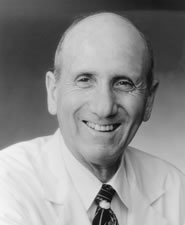| You are here: Home: BCU 1|2004: Saul E Rivkin, MD


Edited comments by Dr Rivkin
Case study: Patient preference for a nonanthracyline-based regimen
I initially evaluated this highly intelligent 44-year-old school nurse three years ago when she presented after a lumpectomy with an ER-negative, HER2-negative tumor and four positive axillary nodes.
I offered her FAC and paclitaxel, and she refused this therapy. She had heard very negative descriptions about the alopecia and cardiotoxic effects of FAC, and she is from a part of Washington state where many people don't believe in chemotherapy. She was also concerned that the therapy would interfere with her job and lifestyle.
She had a great deal of family support for her decision to decline this chemotherapy regimen. She agreed to take CMF but was aware that this therapy might not reduce her risk as much as other regimens. She did well for three years and then developed a lump in her breast, which she detected herself.
Follow-up of patients after treatment of a primary tumor
I believe we should do more intense follow-up in practice - if we detect tumor recurrence earlier, we can do a better job of treating it. This patient didn't come back for regular follow-up, and she skipped several visits, which is not uncommon. I check tumor markers on my patients all the time, but hers were not positive and her liver enzymes were normal.
I do not agree with the ASCO guidelines and the movement away from the concept of early diagnosis of tumor recurrence. I had a patient with one bony metastasis 21 years ago. We gave her CAF chemotherapy and radiation to the lesion, and she is still alive today with no other metastases.
Diagnosis of metastatic disease
It is difficult to evaluate breasts that have undergone radiation, and this patient's breast was indurated from the radiation; however, the lesion on physical exam was between two and four centimeters. Her performance status at that time was 100 percent - in fact, she is an avid kayaker and was completely asymptomatic.
We did a complete staging workup, and she had four lesions in the liver. Biopsies indicated ER/PR-negative, HER2-negative breast cancer. She was devastated and saw the end of her life before her. She had good social support from her husband, family and friends. We also have two full-time social workers, a wonderful support group, and our oncology nurses are available to help our patients cope with the emotional aspects of their disease.
Treatment of asymptomatic metastatic disease with combination chemotherapy
At that point, I treated her with weekly chemotherapy with doxorubicin, cyclophosphamide and paclitaxel using growth factor support. She tolerated the therapy well despite hair loss and some anemia. Neuropathy is generally less severe when paclitaxel is given on a weekly schedule as opposed to every three weeks.
I believe patients with Stage IV disease tolerate chemotherapy better than those with Stage II disease because their lives are on the line. While she had previously dreaded losing her hair, nothing bothered her now. She continued to work and she continued to kayak throughout her treatment.
Many physicians would have treated her with sequential single agents, and several studies show that this approach is just as good as combination chemotherapy. I was motivated by her young age and her emotional reaction - I believe she would have balked at a single-agent approach.
She's had more than a 50 to 60 percent response in the breast and still has lesions in the liver. I recently started her on capecitabine. When she progresses, it is going to be tough, but she's optimistic and she's a fighter. Maybe there will be something else out there for her - bevacizumab, gefitinib or maybe a new drug.
Capecitabine: Dosing and scheduling
Capecitabine is an excellent drug and very efficacious. The oral agents are wonderful for cancer patients, and capecitabine has a great reputation in Seattle. My patients say it works, and taking three or four pills per day is pretty easy. I usually dose capecitabine at 1,000 mg/m2 twice a day for 14 days and then one week off.
I have a patient with liver metastases who is going on her fourth year on cape-citabine. I started her on the full dose, but she actually dose-reduced herself, and she takes it five days in a row every two weeks. Her liver is now disease-free.
It will take us a long time to determine the pharmacokinetics of this drug and how best to deliver it. We have typically given two weeks on, one week off, but why not give continuous low-dose therapy?
Educating patients about potential toxicities with capecitabine
We are very careful and instruct patients to call us at the first sign of diarrhea. The major concern is that patients won't call us. To treat the hand-foot syndrome, we have used celecoxib or rofecoxib and Vitamin B-6 - I don't know if it works or not.
Progress in breast cancer
I like to make sick people well again, and I believe we can help our patients to live longer. We have data in our center demonstrating that our patients do better than the national average. Right now approximately 17 percent of our breast cancer patients have carcinoma in situ.
In our early studies, 60 percent of our patients had four or more positive nodes, and 12 to 13 percent of these had 10 or more positive nodes. Currently, in our adjuvant studies, only 20 percent of our patients have four or more positive nodes. We're doing better with adjuvant therapy - the tumors are smaller, the nodes are fewer and hopefully, the drugs are better.
Select publications
|
| Dr Rivkin is a Medical Oncologist at the Swedish Medical Center Cancer Institute, Principle Investigator of the Southwest Oncology Group, Regional President of PSOC, and Clinical Professor of Medicine at the University of Washington in Seattle, Washington. |
|
